The most important aspect of effective play on the basketball court at either end of the floor than spacing.
All good offenses have good spacing and movement. Except when screening or cutting around a teammate, perimeter players should space out about 12 to 15 feet apart. Poor spacing results in bad passes, getting double-teamed, turnovers, and poor opportunities for scoring. You must maintain good spacing from the ball and fill the open spots of the court.
Perimeter players should space out above the 3-point arc. If you are inside the arc for no particular reason, you are most likely “clogging” things up for your teammates, and making it easier for the defense.
Effect of good spacing on the defense
1. Spacing makes it harder to defend dribble-penetration as the help defenders have more distance to cover when coming off their man.
2. Consequently, spacing makes it harder to defend perimeter shooters, as the helpside defender in the paint has more distance to get back out to the shooter, if the pass goes there.
3. Spacing also makes it harder to defend post players. Teams that double-team the low post will have a difficult time when players are spaced apart. Good spacing allows for hi-lo passing from one post player to another, when the perimeter players are spaced out on the arc, and their is no help side defense.
4. Spacing makes it harder to defend cutters.
5. Spacing makes it harder to deny the passing lanes.
3-out, 2-in offense
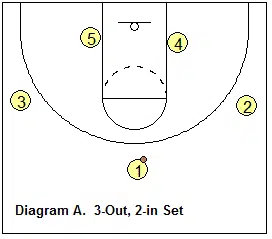
With the 3-perimeter, 2 post offense both post players may start low on the blocks, or one may start at the high post and one starts low. As the ball moves, they work together and interchange spots, using both sides of the lane.
4-out, 1-in offense
The 4-out offense has four perimeter players spaced out on the 3-point arc, with one post player, who can either start low or high (at the free throw line area).
The “low” set, with the post player in the weakside low short corner or block area, allows for spacing for cutters and the dribble-drive. When the ball is swung and post player is ball-side, he/she can post up.

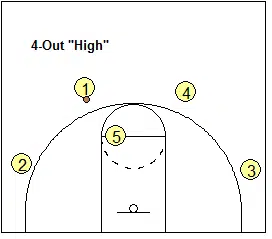
The “high” set, with the post player at the high post, allows for spacing for cutters underneath from the wings, and baseline dribble-penetration. The high post player is also used for (high post) screens, “pinch-post” hand-offs, back-screens for perimeter players, ball-screen pick and roll action, and perimeter flare-screens.
Cutting and Spacing
If you just passed the ball to a teammate, don’t stand still – cut! Pass and cut and fill another spot on the perimeter.
Cutters must “cut with a purpose” and try to get open for a pass, and not just make a lazy cut to the basket. The cutter should make a good fake, a hard cut, have his hands ready and expect to get the pass for a quick score. An adjacent perimeter player will usually fill the spot vacated by the cutter.
If a perimeter player is being over-played (denied) by the defender, he/she should back-cut through and fill another spot on the perimeter. Or make a V-cut, taking the defender inside and quickly cutting back out for the pass. Or curl around a post player inside. Or set a screen.
If the cutter does not receive the pass, he/she should get out to the 3 point line, filling an open spot on the perimeter, and not “get stuck” inside or along the baseline, which clogs things up. The cutter could also screen for the post player inside.
Dribble-penetration and Spacing
When a player dribble-drives, other perimeter players rotate and fill the open spots according to the rules of the offense that your coach is using. Perimeter players should “space-out” to open spots on the perimeter for a kick-out pass.
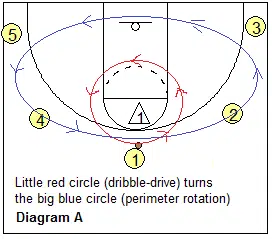
Like cutting, when a perimeter player dribble-drives, usually an adjacent perimeter player will fill his/her vacated spot on the arc. If the dribble is stopped inside, this player filling the vacated spot is usually open for a pass back outside. See diagrams B and C below. As 1 dribble-drives, 4 rotates to the vacated “safety” spot and may be open for the next pass and 3-point shot.
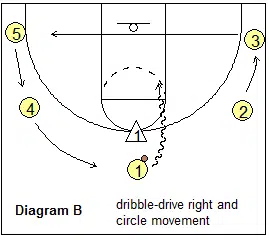
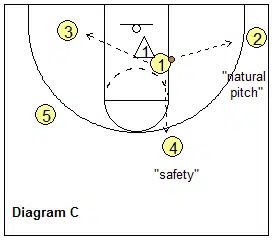
Dribble-drive from the top. Also notice (in diagrams B and C above) that when the point guard drives, the wing player slides down to the corner for an open kick-out pass (if his/her defender gives help inside on the dribble-drive).
Wing baseline dribble-drive. When the wing dribble-penetrates along the baseline, three things should occur:
1. The opposite perimeter player slides down to the weakside corner for a possible pass from the dribbler.
2. The post player(s) I-cut to the elbow. The I-cut allows for spacing for the dribbler and also often gets the post player open for a pass from the dribbler.
3. The adjacent top perimeter player fills the perimeter spot vacated by the dribbler.
Diagram I below shows the 4-out baseline dribble, with the post opposite. 2 fills the vacated spot, 5 I-cuts to the weakside elbow and 4 drops down to the weakside corner. Diagram J shows the same thing, only with the post player ball side. 5 I-cuts up to the ball side elbow.
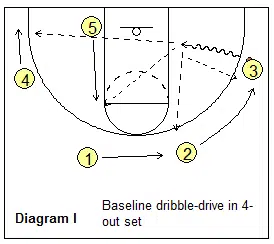

Diagram K below shows the 3-out, 2 posts baseline dribble. 2 fills the vacated spot, 4 and 5 cut to the elbows, and 3 drops down to the weakside corner.
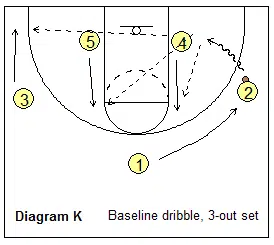
Wing dribble-drive into the middle (elbow). When the ball is dribbled toward the middle, the opposite weakside perimeter player(s) should spot up on the arc at the wing or corner areas for a kick-over pass. The low post player should space out to the short corner area, or the opposite block (see diagram Q below).
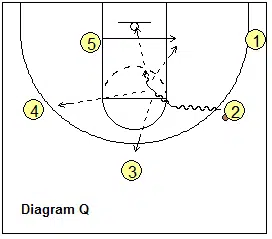
Screening and Movement
Another thing that a player without the ball can do is set a screen. After screening, seal the defender and cut, roll, flare, slip, etc. When the defense switches the screen, it’s often the screener that gets open. A perimeter player could lateral screen, flare-screen, down-screen, or ball-screen and roll inside or pop back out.
Post players can ball-screen and run the pick and roll (or a pick and pop). They can back-screen for perimeter players. They can lateral screen for another post player (if playing Motion).
Perimeter players and Movement
Four things a perimeter player can do after making a pass:
- Cut to the basket (example: give and go, or back-cut). Back cut if the defender is denying the pass.
- V-cut and pop back outside for the return pass and outside shot.
- Screen for the ball.
- Screen away.
Things a perimeter player can do when he/she doesn’t have the ball:
- If you have an under-play (defense sagging off), pop out to spread the defense.
- If you have an overplay (being denied), back-cut through to the hoop and then fill outside.
- Someone dribbling at you, back cut inside, or run a simple weave-screen.
- Fill the open spot when a teammate cuts inside.
- When someone dribble-penetrates, relocate.
- Screen away, and pop out.
- The most important rule is to keep moving.
Post players and Movement
Things post players can do:
- Post-up – try to get open for the pass inside, so you can make a post move. See “How to Become a Good Post Player” to learn how to get open.
- If you can’t get open, screen for the opposite post player.
- If you can’t get open, set a ball-screen and run the pick and roll.
- If you are playing with two post players, work with your opposite post player. Screen for each other. Play “hi-lo“, one at the high post and one inside, moving and rotating in these spots as the ball moves. For example, if the ball is on the opposite wing and you see that your teammate is being full-fronted in the low post, cut to the ball-side elbow for the pass, and then dump the ball inside from there.
- React correctly to dribble-penetration (see above). I-cut on the baseline dribble; go short corner on the dribble from the top.
As we have seen above, there are things to do when you don’t have the ball.
Always be aware and know where the ball is. Be alert to help a teammate if he/she stops the dribble or is in trouble. Be ready to jump in after loose balls. Be ready to rebound when the shot goes up. Be alert and position yourself for a rebound. You’ll get extra shots and points this way.
Remember, often it is not the person initially with the ball who scores. Instead a good pass to you cutting, or coming off a screen, is where the score comes. So work hard on offense when you don’t actually have the ball.
